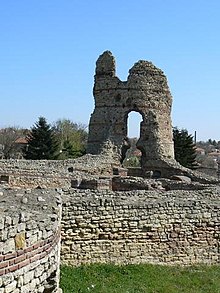Kula (Bulgaria)
| Kula (Кула) | ||||
|
||||
| Basic data | ||||
|---|---|---|---|---|
| State : |
|
|||
| Oblast : | Vidin | |||
| Residents : | 2821 (December 31, 2016) | |||
| Coordinates : | 43 ° 53 ' N , 22 ° 31' E | |||
| Height : | 204 m | |||
| Postal code : | 3800 | |||
| Telephone code : | (+359) 0938 | |||
| License plate : | bra | |||
| administration | ||||
| Mayor : | Marko Petrov | |||
| Ruling party : | Bulgarian Socialist Party | |||
| Website : | www.kulamunicipality.com | |||
Kula ( Bulgarian Кула , to dt. "Tower") is a city in northwestern Bulgaria . The place is in the Vidin district . Kula is the third largest city in the district after Vidin and Belogradchik .
location
The town of Kula is located in the far northwest of Bulgaria, around 32 km from Vidin and around 13 km from the Bulgarian-Serbian border crossing GKPP Wraschka Chuka .
history
Ancient and Middle Ages
In the first century AD, the Roman Empire conquered the areas between the Balkan Mountains and the Danube , which were then incorporated into the province of Moesia. Along the Danube were built a fixed limit, the Donaulimes and Via Istrum which followed the limit. In this context, forts and fortresses were built, one of which was Castra Martis. The city secured a branch from Via Istrum to Via Militaris in Naissus over the Wraschka Tschuka pass in the western Hemus Mountains (ancient name of the Balkan Mountains). The fortress is named after the god of war Mars .
With the conquest of Dacia by the Roman Emperor Trajan , the border shifted to the north. At the end of the 3rd and beginning of the 4th century, after the abandonment of Dacia under Emperor Aurelian , the lower Danube Limes (Mösischer Limes) was rebuilt and reinforced, including Castra Martis.
Castra Martis was an important bishopric, whose bishop Calvus took part in the synod of Serdica in 342 . In 378 the Western Roman Emperor Gratian stayed here after the Battle of Argentovaria . He was on his way to Adrianople to help the Eastern Roman Emperor Valens with weapons against the Goths (→ Battle of Adrianople ). In 408 or 409 it was taken by the Huns under Uldin , who subsequently sacked Thrace .
In the 4th century Castra Martis was also affected by the raids of the Goths . According to Prokopios of Caesarea , Castra Martis was one of the fortresses that the Eastern Roman Emperor Justinian I (527-565) had built against the invasion of Slavic tribes . The rebuilt fortress was taken by Slavs and Avars in the 6th century . During the Avar invasion of 586/587, the ancient Castra Martis was finally destroyed.
In the following centuries the center of the region shifted to nearby Vidin. Only in the 13th and 14th centuries, during the Second Bulgarian Empire and the Kingdom of Vidin, was the fortress built and fortified. She was one of the cornerstones of Vidin’s defense. In 1396 the fortress was captured by the Ottoman Turks and finally destroyed.
The ancient fortress was located by the Austrian explorer Felix Philipp Kanitz . In the town there is a local museum with finds from the fortress and a miniature model of Castra Martis .
The current name of the city is derived from the still preserved tower (Bulgarian Kula) of the fortress. Via its ancient name, the city has given its name to Castra Martis Hill , a hill on Livingston Island in Antarctica, since 2005 .
Ottoman rule
With the Ottoman rule, Kula was incorporated into the Sandschak Widin (administrative units in the Ottoman Empire). In the 18th century it belonged to the domain of the renegade Janissary Osman Pazvantoğlu . Kula also benefited from the economic boom in nearby Vidin due to the increase in navigation on the Danube. However, when the neighboring Lom was connected to the capital Sofia by a country road in 1866 , Vidin fell behind and its hinterland deteriorated noticeably.
The revolt of Pujo Wojwoda against the Ottoman rule is recorded from 1846. In 1850 the population of Okolija (municipality) Vidin, Kula, Lom and Belogradchik tried the uprising ( Vidin uprising ), which was brutally suppressed.
After the Crimean War (1853-1856) 600 Circassian families were settled in Kula . The reign of Midhat Pasha over the Vilayet Tuna (Greater Province) ushered in several reforms. The road to Vidin was renewed and the first Bulgarian school in Kula was opened in 1859, financed by the Bulgarian community. The Church of Petar and Paulos was built between 1863 and 1864 . The people of Kula took part in the bloody April uprising of 1876. The fallen freedom fighters were buried in the nearby Rakovsky Monastery.
With the liberation of Bulgaria after the Russo-Ottoman War of 1877/78, a Russian company was stationed in Kula.
Industry
The most important industries are rubber and plastic production.
People associated with the city
- Dimitar Popow (1927–2015), Bulgarian legal scholar, politician and Prime Minister
Individual evidence
- ↑ The fortress Castra Martis in Kula (bulg.)
- ↑ Fionera Filipova ( page no longer available , search in web archives ) Info: The link was automatically marked as defective. Please check the link according to the instructions and then remove this notice. , Head of the Historical Museum in Vidin about Castra Martis (bulg.)
- ↑ Franz Altheim: The European Huns , Walter de Gruyter, 1975, p 186
- ↑ Veselin Beševliev : The Proto-Bulgarian Period in Bulgarian History , Hakkert, 1981, p. 14


